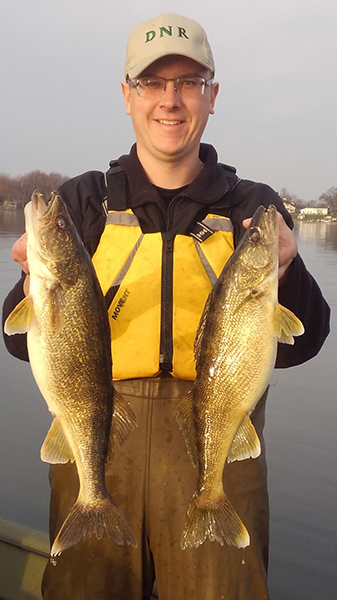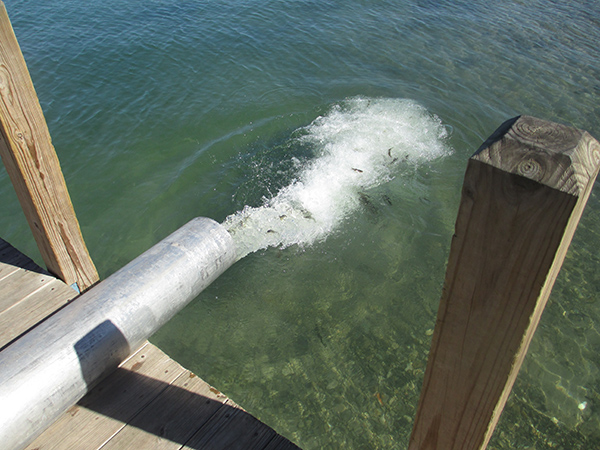- Details
The Indiana DNR comes across a big walleye or two near the Michigan City breakwall every year while doing Lake Michigan fish surveys.
This year was no exception. Lake Michigan Biologist Dickinson said they netted a 27-inch, 9 pounder recently. They also captured some smaller ones in the 5-pound range.
“We’ve netted big walleye out there each year for the past five or six years,” he said. “This one was one of the smaller ones.”
If you’re interested in trying to catch one, Dickinson said the walleyes they net are usually very tight to breakwall.
Who knows…there may be a state record lurking out there!
- Details
By Louie Stout
 Indiana Biologist Tom Bacula
Indiana Biologist Tom Bacula
Indiana Biologist Tom Bacula shows off a pair of nice walleyes his crew collected during a survey on Lake Maxinkuckee. Bacula was impressed with the numbers and quality of walleyes his crew turned up. (Indiana DNR photo)
If you fish Lake Maxinkuckee in Culver, Ind., you probably know the lake has walleyes.
The 1,884-acre lake has been stocked with walleyes for several years. It has never been a great walleye fishery, but if you’re skilled at targeting the prized fish, you can catch a few legal-size fish.
Those odds are improving, however, as a recent DNR survey reveals the lake has more adult walleyes than ever and shows promise of getting even better.
Maxinkuckee is the second largest natural lake in Indiana. It has beautiful structure, habitat and good water quality that benefit a variety of gamefish.
Unfortunately, the public access leaves little to be desired. The DNR manages a boat launch but parking is limited to an area along the road.
It’s too bad, because the lake is a fabulous fishery for a variety of species.
- Details
By Louie Stout
If you’re looking for a giant walleye, consider Michigan’s Tittabawassee River. Biologists netted a 16 pounder there while doing a jaw tagging study there. Tags are placed on walleyes then released. When the fish is caught by anglers and the number off the jaw tag is reported, it helps biologists learn more about how many fish are being caught and how the fishery is operating. Some tags carry cash prizes.
The giant walleye fish netted that day missed the state record by 1.19 pounds. The current record, caught from Manistee County’s Pine River, has stood for 68 years.
- Details
By Louie Stout
 PNA Club Stocks Walleyes in Diamond Lake
PNA Club Stocks Walleyes in Diamond Lake
The P.N.A. Fisherman’s Club – one of the oldest in Indiana – stocked walleyes in Diamond Lake at Cassopolis recently.
The club pays for stocking walleyes in a Michiana lake each year, a generous act it’s been doing for more than 20 years. This year, 550 fall fingerlings measuring 6 to 8 inches were planted in Diamond.
“We had hoped to stock them in Indiana’s Fish Lake near North Liberty, Ind., but the Indiana DNR said we couldn’t get the permit unless each fish was tested for a virus,” said club spokesman Ted Wasielewski. “That was going to cost an extra dollar per fish.”





